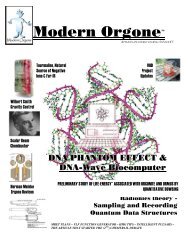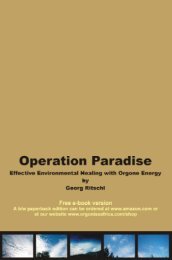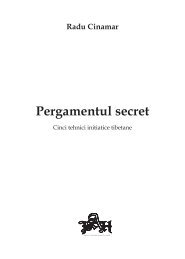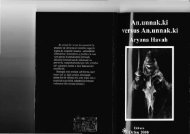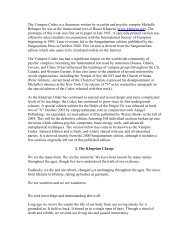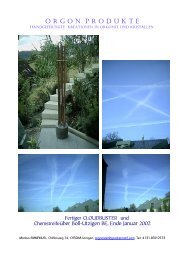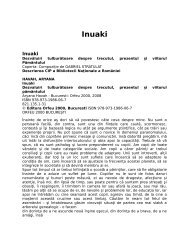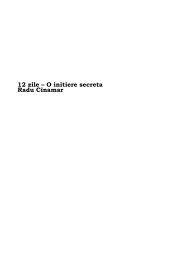Modern Orgone - Transkommunikation.ch
Modern Orgone - Transkommunikation.ch
Modern Orgone - Transkommunikation.ch
Create successful ePaper yourself
Turn your PDF publications into a flip-book with our unique Google optimized e-Paper software.
<strong>ch</strong>ange of the constituent basis of that te<strong>ch</strong>nology,<br />
in the history of analogue > to > digital > to > now,<br />
the figurative semantic (nonlocal) wave computer<br />
or biocomputer. This biocomputer will be based on<br />
new understanding of the higher forms of the DNA<br />
memory, and the <strong>ch</strong>romosome apparatus, as the<br />
recording, storaging, transducing and transmitting<br />
system for genetic information, that must be<br />
considered simultaneously both at the level of<br />
matter and at the level of physical fields. The latter<br />
fields, having been just studied, as showed<br />
experimentally in this resear<strong>ch</strong>, are carriers of<br />
genetic and general regulative information,<br />
operating on a continuum of genetic molecules<br />
(DNA, RNA, proteins, etc). Here, previously<br />
unknown types of memory (soliton, holographic,<br />
polarization) and also the DNA molecule, work<br />
both as biolasers and as a recording environment<br />
for these laser signals. The genetic code, considered<br />
from su<strong>ch</strong> a point of view, will be essentially<br />
different from today’s generally accepted but<br />
incomplete model. This, the wave-biocomputer<br />
model asserts, only begins to explain the apparatus<br />
of protein biosynthesis of living organisms,<br />
providing an important interpretation for the initial<br />
stages within this new proposed composite<br />
hierar<strong>ch</strong>ic <strong>ch</strong>ain of material and field, sign,<br />
holographic, semiotic-semantic and, in the general<br />
case, of figurative encoding and deciphering<br />
<strong>ch</strong>romosome functions. Here the DNA molecules,<br />
conceived as a gene-sign continuum of any<br />
biosystem, are able to form pre-images of<br />
biostructures and of the organism as a whole as a<br />
registry of dynamical “wave copies” or “matrixes”,<br />
succeeding ea<strong>ch</strong> other. This continuum is the<br />
measuring, calibrating field for constructing any<br />
biosystem.<br />
1.3 Features of the Wave Model<br />
Adleman [1994], for example, has used the<br />
me<strong>ch</strong>anism for fast and precise mutual recognition<br />
between the DNA anti-parallels half-<strong>ch</strong>ains to solve<br />
the “the travelling salesman’s problem”. However<br />
in the wave model of biosystems, this is only one<br />
aspect of the self-organization taking place. For<br />
here, as the experimental evidence now confirms,<br />
the mutual recognition of one DNA anti parallel<br />
half <strong>ch</strong>ain (+) by the other (-) concerns special<br />
super persistent/resonant acoustic-electromagnetic<br />
waves or solitons. Su<strong>ch</strong> DNA solitons have two<br />
connected types of memory. The first is typical of<br />
the phenomenon discovered by Fermi-Pasta-Ulam<br />
(FPU) [Fermi, 1972]. It concerns the capability of<br />
non-linear systems to remember initial modes of<br />
energisation and to periodically repeat them<br />
[Dubois 1992]. The DNA liquid crystals within the<br />
<strong>ch</strong>romosome structure form su<strong>ch</strong> a non-linear<br />
system. The second is that of the DNA-continuum<br />
in an organism. Su<strong>ch</strong> memory is an aspect of the<br />
genome’s nonlocality. It is quasiholographic/fractal,<br />
and relates, as is the case for<br />
any hologram or fractal, to the fundamental<br />
property of biosystems i.e. to their ability to restore<br />
the whole out of a part. This property is well known<br />
(grafting of plants, regeneration of a lizard’s tail,<br />
regeneration of a whole organism from the oocyte).<br />
And a higher form of su<strong>ch</strong> a biological memory<br />
would be a holographic (associative) memory of the<br />
brain cortex, i.e. of its neural network [Pribram<br />
1991; S<strong>ch</strong>empp 1992; Marcer S<strong>ch</strong>empp 1997,<br />
1998; Sutherland 1999]. Su<strong>ch</strong> wave sign<br />
encoding/decoding therefore, like DNA’s ability to<br />
resolve “the travelling salesman’s problem”, is, it<br />
can be hypothesized, an integral part of DNA’s<br />
computational biofunctionality. Indeed DNA<br />
solitary waves (solitons), and in particular, the<br />
nucleotide waves of oscillatory rotation, “read” the<br />
genome’s sign patterns, so that su<strong>ch</strong> sign vibratory<br />
dynamics may be considered as one of many<br />
genomic non-linear dynamic semiotic processes.<br />
The expression “DNA’s texts”, borrowed earlier as<br />
a metaphor from the linguists, is it turns out<br />
therefore related directly to actual human spee<strong>ch</strong>.<br />
For as mathematical-linguistic resear<strong>ch</strong> into DNA<br />
and human spee<strong>ch</strong> textual patterns, shows [Maslow,<br />
Gariaev 1994] the key parameter of both su<strong>ch</strong><br />
patterns is fractality. It can therefore be<br />
hypothesized that the grammar of genetic texts is a<br />
special case of the general grammar of all human<br />
languages.<br />
Returning however to DNA computation based on<br />
matter-wave sign functions with a view to realizing<br />
its wave coding capabilities, as distinct those used<br />
by Adleman, whi<strong>ch</strong> might be termed its matter<br />
capabilities. Su<strong>ch</strong> true wave control capabilities of<br />
the DNA or <strong>ch</strong>romosomes are, we hypothesize,<br />
those conditions that apply inside the living cell, i.e.<br />
in an aqueous solution but whi<strong>ch</strong> correspond to a<br />
liquid-crystal condition as well. For under su<strong>ch</strong><br />
conditions, in the unique circumstances of cell<br />
division, the living cell has the ability to replicate<br />
itself, and has the property of what in relation to a<br />
self replicating automaton, von Neumann [1966]<br />
called “universal computer construction” so that<br />
we may say that the living cell is su<strong>ch</strong> a computer<br />
based on DNA [Marcer S<strong>ch</strong>empp 1997a]. And<br />
while the artificial cloning of a single cell is not yet<br />
feasible, what we have been able to do, is to record<br />
the DNA-wave information appropriate to these<br />
wave sign conditions of the DNA in a cell on laser<br />
10



